The Student Counseling Center may have shorter wait times and more personalized therapy in the coming year, thanks to a new Student Government initiative to implement an online therapy program.
The center has seen rapid growth in the number of students requesting counseling services. According to the SCC, student intake increased 28 percent from the 2014-2015 academic year to the 2015-2016 academic year, which has resulted in a growing waitlist.
“It became a sustained and growing problem just in the last few years,” said Jim Cannici, the director of the SCC. “It’s very much because we’ve become such a bigger university than we were. Over the years, we have been given more staff to provide services, but we can’t seem to keep up with the demand that there is.”
As part of a larger restructuring to ease strain on its staff, the SCC is exploring the possibility of implementing Therapy Assistance Online, a software that combines online treatment programs with video chat-based therapy sessions.
Cannici said the primary benefit of TAO is to improve the reach of the SCC.
“It’s more to give greater access to those that are less able to access our services,” he said. “We are open one evening a week, but a lot of our students — especially graduate ones — have full time jobs and so they can’t come in to access our services.”
SG Vice President Joey Campain proposed the idea in the fall of 2016 while serving on UT System’s Student Advisory Committee. The committee focused on graduate mental health and methods to implement counseling accessibility.
“On our campus, we have specific groups of graduate students that are very disconnected from life on campus,” Campain said. “They come to campus and spend the majority of their time in BSB or NSERL. Nothing really requires them to come to the interior of campus. How can we provide a service to students that never will have interactions with the Counseling Center?”
With the new software, students would only have to come to the SCC once to be paired with a UTD counselor and to undergo an intake session to determine the level of care needed. Students are categorized into one of four levels: critical, high, medium or low priority. Those with critical or high priority, which includes suicidal thoughts or self-injurious behavior, will be treated through in-person therapy at the SCC.
Those with medium or low priority, which can include academic stress or anxiety, will receive treatment through TAO modules and video chat sessions. Each video session lasts around 30 minutes instead of the normal hour, which has the potential to increase the number of clients a therapist can see in a day.
A 2016 article published in Professional Psychology: Research and Practice compared the effectiveness of TAO and traditional therapy in a study of 72 college students with anxiety. TAO was found to be more effective in terms of long-term improvement.
Cannici noted that TAO is uniquely positioned for treating UTD students seeking therapy.
“It’s something that — on the surface — looks pretty well designed,” he said. “Our population here, particularly, is so used to doing online activities. It would appear to be a good fit for our population.”
Counselors can assign modules, conduct video chats and monitor overall progress. However, if conditions don’t improve, students will be asked to attend in-person counseling sessions at the center.
“It doesn’t mean it’s going to be effective for everybody,” Campain said.
Cannici agreed, emphasizing the importance of face-to-face interactions.
“One of the great advantages of counseling is that one-on-one eye contact, non-verbal behaviors (and) tone of voice — which is less accessible through the online program,” he said.
The cost to license TAO is $21,060 per year, which includes unlimited clients and therapists. Because of the relatively low cost, Cannici said he doesn’t anticipate any extra fees for students.
“$21,000 isn’t all that expensive,” he said. “A new psychologist or a new staff member would be much more than that.”
Cannici said the decision to integrate TAO into the SCC is still awaiting approval from the administration. If approved, it could be implemented as late as 2019.

















